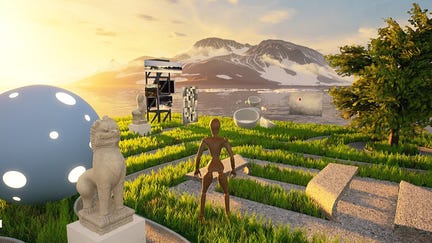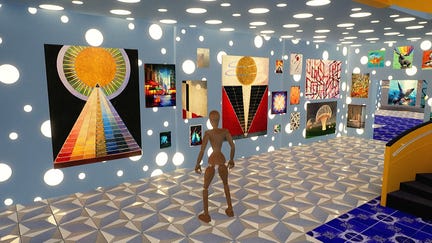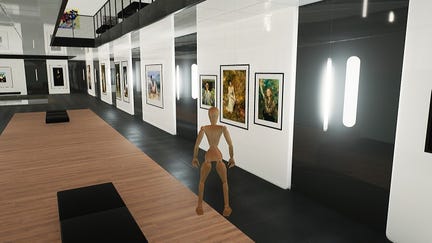Occupy White Walls review: create and curate your own personal art gallery
Colour me impressed
Back in 2020, a group of digital art smugglers lifted the National Gallery’s entire art collection, nabbing each of the 2,400 hi-res digital artworks straight from the institution’s website. Since the collection is made up of paintings long past their copyright expiration, countless works by Van Gogh, Da Vinci, Titian, Vermeer, Rembrandt, and the rest were all legally (technically) snatched up in what could have well been the biggest digital heist in art history.
The cheeky looters in question were StikiPixels, the very same team behind the art gallery sim Occupy White Walls, and now anyone who owns a PC and a copy of the game can hang these priceless paintings in their own private virtual collections. In OWW (officially pronounced Owouawwouaw if you have the time), you can build your own architecturally ambitious gallery and stuff it full of artwork.
Riffling through a lavish catalogue, you can choose from hundreds of floors, doors, ceilings, windows, and furniture to create the art gallery of your dreams. Galleries have a bit of a reputation for being a bit, well, stuffy, but the resources in OWW let you design your gallery space however you like. You can create everything from gorgeous grand halls inspired by art nouveau to sleek, futuristic nightclubs dedicated to the paintings of Renaissance bad-boy Caravaggio.
After booting up the game, you’re given your first sandbox space which has a run-down art gallery at its centre, and exposed brick walls bare of any paintings. You can spruce it up if you’re liking the vibe, but the first thing I did (and my advice is that you should follow suit) is to delete everything and start building completely from scratch - a nice clean slate to brain splat your ideas on to. Materials and art cost money but you’re given a delicious small fortune when you start and it's a lump sum that you can do a lot with.
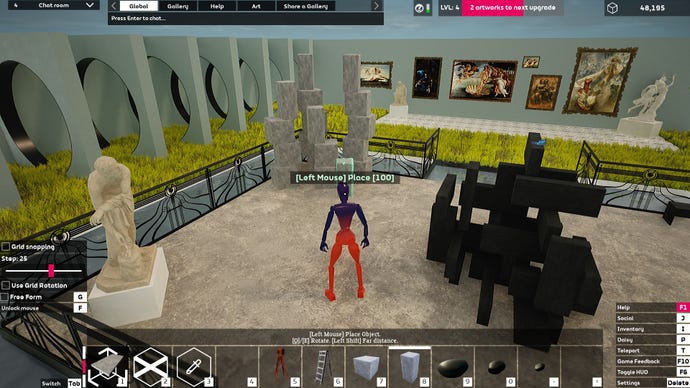
Controls are as easy as selecting something from the catalogue, dragging it into your inventory wheel at the bottom of the screen, and plonking it down in your space. Walls and floors connect effortlessly and thanks to the sandbox's grid system you can make sure everything is perfectly symmetrical. I’ve always liked the idea of an outdoor gallery and so - because I’m a classy gal - I designed a relaxing open-aired garden complete with bright white walls, crystal platforms, high-density speckled concrete, lavish stone statues, and a plethora of gorgeous baroque paintings. The only thing missing from the catalogue are individual material names. Trying to work out which speckled concrete floor I had used out of the handful of identical ones that all have the exact same name was a small annoyance in a relatively relaxing building process.
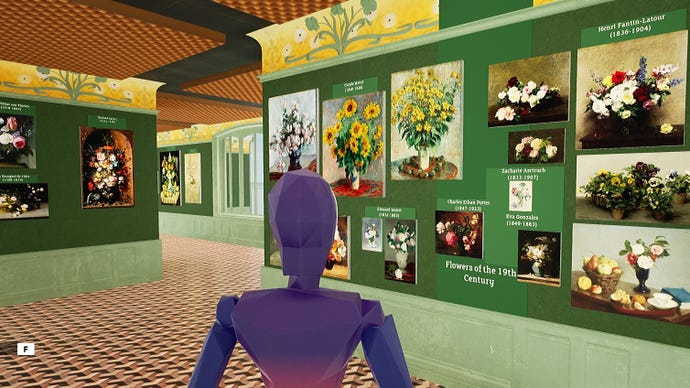
To help you decide what art to slap on your gallery's walls is DAISY, an in-game AI who recommends pieces of art based on the paintings you've bought before. If you have a passion for Turner’s epic stormy sea paintings, DAISY will fill your screen with water-logged seascapes from a bunch of different artists throughout history. Alas, if you're after a specific piece of art, there’s no search bar to track it down immediately. Instead, you'll need to click through DAISY's seemingly endless supply of paintings, which can be a bit of a chore, but the flip side to that is that it does means you get to discover a whole host of new artwork you might not have been exposed to before. Every artist is treated the same within DAISY's system, so you'll find no special treatment here. It's pretty cool seeing something like the Mona Lisa nestled in with a bunch of unknown artists.
However, the best part of DAISY (and Occupy White Walls being an MMO) is that you can see comments that other players have left next to paintings and, as you can imagine, they are incredible. Francisco Goya’s Saturn Devouring his Son, arguably one of the darkest European paintings in art history, will be accompanied by comments such as ‘D-e-licious!’ and ‘LOOKS LIKE A SNACK.’
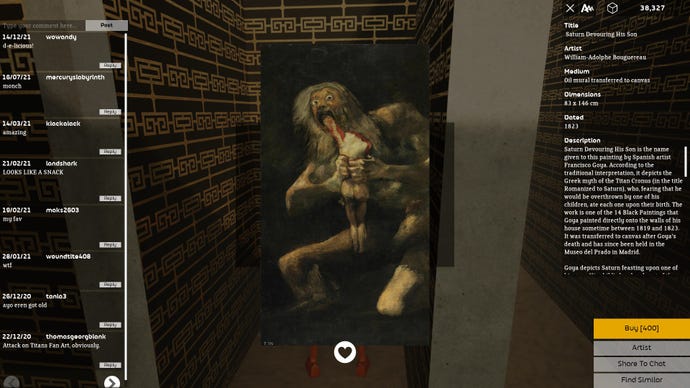
There's also the option to upload your own artwork and make an entire gallery dedicated to yourself in a major girl boss move. I haven’t uploaded anything as the only art I've created are the hundreds of photos I've taken of my cat. Saying that, an entire museum dedicated to Wizard the one-eyed wonder does sound appealing...
Buying shopping bags full of artwork levels you up, which in turn unlocks more materials and furniture for you to use. When you're satisfied with the state of your gallery, you can open it up to the rest of the OWW community. There’s a big social element to OWW and engaging with its community (who have all been super nice based on what I've played so far) is a lovely boost of serotonin you didn’t know you needed. Opening your gallery is also how you can start earning money, represented as little blue cubes. Visitors can leave comments, buy paintings, and deposit little ‘thank you’ tips on your reception table.
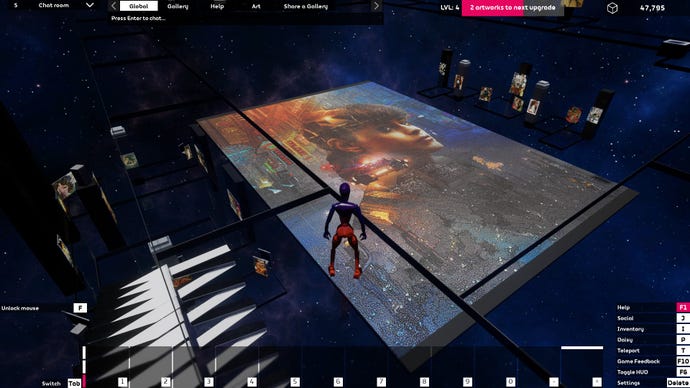
If your creative juices are running low, teleporting to other people’s galleries is the quickest way to ignite your creative spark. You can scroll through the game’s ‘Featured’ section to see plenty of spectacular builds or, if you're feeling particularly adventurous, there's a button that will take you to a random gallery that's currently open. One of my favourite activities became hopping between random galleries, seeing where OWW's algorithmic shuffle would spit me out. One gallery I visited was dedicated to artwork depicting the apocalypse, the gallery styled like the remnants of an ecological disaster. Another was filled with vaporwave lighting and abstract art complete with a giant Blade Runner mosaic covering the entire floor.
OWW is all about showing your own artistic vision through curation and building architecture. Its approach to the somewhat stuffy art world is playful while also giving a middle finger to those who wish to keep the enjoyment of art to a certain elite. It's an incredible niche game but has the uncanny ability to suck you in with its breezy building and incredibly creative community, even if you can't tell your Monet from your Manet.
